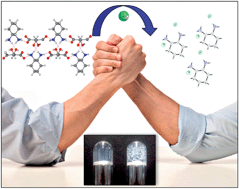Competition between gelation and crystallisation of a peculiar multicomponent liquid system based on ammonium salts†
Abstract
An exemplar competition between

* Corresponding authors
a
Institut für Organische Chemie, Universität Regensburg, Universitätsstr. 31, 93053 Regensburg, Germany
E-mail:
David.Diaz@chemie.uni-regensburg.de
Fax: +49 941 9434121
Tel: +49 941 9434373
b Instituto de Síntesis Química y Catálisis Homogénea (ISQCH), CSIC-Universidad de Zaragoza, Pedro Cerbuna 12, 50009 Zaragoza, Spain
c Physical/Materials Chemistry Division, National Chemical Laboratory, Dr Homi Bhabha Road, Pune 411008, India
d Istituto di Metodologie Chimiche (IMC), Consiglio Nazionale delle Ricerche (CNR), Dipartimento di Chimica, Università di Firenze, Via della Lastruccia 13, I-50019 Sesto Fiorentino, Firenze, Italy
e Instituto Universitario de Bio-Orgánica “Antonio González”, Universidad de La Laguna, Astrofísico Francisco Sánchez 2, 38206 La Laguna, Tenerife, Spain
An exemplar competition between

 Please wait while we load your content...
Something went wrong. Try again?
Please wait while we load your content...
Something went wrong. Try again?
I. Kapoor, E. Schön, J. Bachl, D. Kühbeck, C. Cativiela, S. Saha, R. Banerjee, S. Roelens, J. J. Marrero-Tellado and D. D. Díaz, Soft Matter, 2012, 8, 3446 DOI: 10.1039/C2SM07183E
To request permission to reproduce material from this article, please go to the Copyright Clearance Center request page.
If you are an author contributing to an RSC publication, you do not need to request permission provided correct acknowledgement is given.
If you are the author of this article, you do not need to request permission to reproduce figures and diagrams provided correct acknowledgement is given. If you want to reproduce the whole article in a third-party publication (excluding your thesis/dissertation for which permission is not required) please go to the Copyright Clearance Center request page.
Read more about how to correctly acknowledge RSC content.
 Fetching data from CrossRef.
Fetching data from CrossRef.
This may take some time to load.
Loading related content
